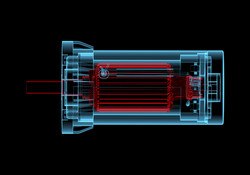Magnetic materials for electric engines
To date, magnetic materials are specified and traded based on data collected using measuring techniques described in international standards. In International Electrotechnical Commission (IEC) 60404, magnetic properties are determined only for sinusoidal-induced voltages and specific values of magnetisation polarisation and frequency. The operating conditions experienced in high-power density electric motors for aircraft are, however, far from ideal, rendering the available data insufficient. EU-funded researchers have recently risen to the challenge of characterising both soft and hard magnetic materials under real electromagnetic and mechanical conditions. Within the project EMMPC (Electrical machine magnetic properties characterisation setup for aerospace application), the researchers developed a high-fidelity test set-up to measure power losses when materials are excited with voltage waveforms of various shapes. Magnetic properties can also be monitored with changing temperature and applied stress. The central measurement unit is the result of combining a 1D and a 2D system, to which nine different sensor systems are connected. Among them, two new Epstein frames are suitable for power loss testing with high frequencies and magnetic flux densities. A single steel strip tester measures magnetostriction and iron loss under stress. Additionally, the new test set-up is able to characterise different types of materials, including solids and laminates, and grain-oriented and non-grain-oriented electrical steels. Besides its ability to distinguish between alternating and rotational flux losses, it can determine the ratio of flux density to magnetic field strength as this varies with flux density, namely saturation. The EMMPC set-up, allowing a wide variety of measurements to be performed on magnetic materials, is a European first. As such, it opens the way for a more detailed and deeper understanding of different losses occurring in materials making up electrical aircraft engines, which is essential for future efficiency improvements. With the data collected under conditions resembling those expected during operation as input, better analytical (or semi-analytical) electrical engine models can be subsequently developed, leading to more efficient design.
Keywords
Magnetic materials, electric engines, aircraft, test set-up, IEC 60404, EMMPC

